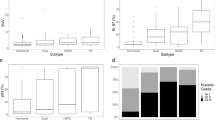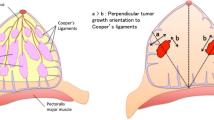Abstract
Purpose
Oncotype DX, a 21-gene expression assay, provides a recurrence score (RS) which predicts prognosis and the benefit from adjuvant chemotherapy in patients with early-stage, estrogen receptor-positive (ER-positive), and human epidermal growth factor receptor 2-negative (HER2-negative) invasive breast cancer. However, Oncotype DX tests are expensive and not readily available in all institutions. The purpose of this study was to investigate whether metabolic parameters on 18F-FDG PET/CT are associated with the Oncotype DX RS and whether 18F-FDG PET/CT can be used to predict the Oncotype DX RS.
Methods
The study group comprised 38 women with stage I/II, ER-positive/HER2-negative invasive breast cancer who underwent pretreatment 18F-FDG PET/CT and Oncotype DX testing. On PET/CT, maximum (SUVmax) and average standardized uptake values, metabolic tumor volume, and total lesion glycolysis were measured. Partial volume-corrected SUVmax (PVC-SUVmax) determined using the recovery coefficient method was also evaluated. Oncotype DX RS (0 – 100) was categorized as low (<18), intermediate (18 – 30), or high (≥31). The associations between metabolic parameters and RS were analyzed. Multivariate logistic regression was used to identify significant independent predictors of low versus intermediate-to-high RS.
Results
Of the 38 patients, 22 (58 %) had a low RS, 13 (34 %) had an intermediate RS, and 3 (8 %) had a high RS. In the analysis with 38 index tumors, PVC-SUVmax was higher in tumors in patients with intermediate-to-high RS than in those with low RS (5.68 vs. 4.06; P = 0.067, marginally significant). High PVC-SUVmax (≥4.96) was significantly associated with intermediate-to-high RS (odds ratio, OR, 10.556; P = 0.004) in univariate analysis. In multivariate analysis with clinicopathologic factors, PVC-SUVmax ≥4.96 (OR 8.459; P = 0.013) was a significant independent predictor of intermediate-to-high RS.
Conclusions
High PVC-SUVmax on 18F-FDG PET/CT was significantly associated with an intermediate-to-high Oncotype DX RS. PVC metabolic parameters on 18F-FDG PET/CT can be used to predict the Oncotype DX RS in patients with early-stage, ER-positive/HER2-negative breast cancer.






Similar content being viewed by others
References
Paik S, Shak S, Tang G, Kim C, Baker J, Cronin M, et al. A multigene assay to predict recurrence of tamoxifen-treated, node-negative breast cancer. N Engl J Med. 2004;351(27):2817–26. doi:10.1056/NEJMoa041588.
Paik S, Tang G, Shak S, Kim C, Baker J, Kim W, et al. Gene expression and benefit of chemotherapy in women with node-negative, estrogen receptor-positive breast cancer. J Clin Oncol. 2006;24(23):3726–34. doi:10.1200/JCO.2005.04.7985.
Albain KS, Barlow WE, Shak S, Hortobagyi GN, Livingston RB, Yeh IT, et al. Prognostic and predictive value of the 21-gene recurrence score assay in postmenopausal women with node-positive, oestrogen-receptor-positive breast cancer on chemotherapy: a retrospective analysis of a randomised trial. Lancet Oncol. 2010;11(1):55–65. doi:10.1016/S1470-2045(09)70314-6.
Dowsett M, Cuzick J, Wale C, Forbes J, Mallon EA, Salter J, et al. Prediction of risk of distant recurrence using the 21-gene recurrence score in node-negative and node-positive postmenopausal patients with breast cancer treated with anastrozole or tamoxifen: a TransATAC study. J Clin Oncol. 2010;28(11):1829–34. doi:10.1200/JCO.2009.24.4798.
Sparano JA, Gray RJ, Makower DF, Pritchard KI, Albain KS, Hayes DF, et al. Prospective validation of a 21-gene expression assay in breast cancer. N Engl J Med. 2015;373(21):2005–14. doi:10.1056/NEJMoa1510764.
Harris L, Fritsche H, Mennel R, Norton L, Ravdin P, Taube S, et al. American Society of Clinical Oncology 2007 update of recommendations for the use of tumor markers in breast cancer. J Clin Oncol. 2007;25(33):5287–312. doi:10.1200/JCO.2007.14.2364.
Groheux D, Hindié E, Delord M, Giacchetti S, Hamy AS, de Bazelaire C, et al. Prognostic impact of 18FDG-PET-CT findings in clinical stage III and IIB breast cancer. J Natl Cancer Inst. 2012;104(24):1879–87. doi:10.1093/jnci/djs451
Mavi A, Cermik TF, Urhan M, Puskulcu H, Basu S, Yu JQ, et al. The effects of estrogen, progesterone, and C-erbB-2 receptor states on 18F-FDG uptake of primary breast cancer lesions. J Nucl Med. 2007;48(8):1266–72. doi:10.2967/jnumed.106.037440.
Shimoda W, Hayashi M, Murakami K, Oyama T, Sunagawa M. The relationship between FDG uptake in PET scans and biological behavior in breast cancer. Breast Cancer. 2007;14(3):260–8.
Basu S, Chen W, Tchou J, Mavi A, Cermik T, Czerniecki B, et al. Comparison of triple-negative and estrogen receptor-positive/progesterone receptor-positive/HER2-negative breast carcinoma using quantitative fluorine-18 fluorodeoxyglucose/positron emission tomography imaging parameters: a potentially useful method for disease characterization. Cancer. 2008;112(5):995–1000. doi:10.1002/cncr.23226.
Koo HR, Park JS, Kang KW, Cho N, Chang JM, Bae MS, et al. 18F-FDG uptake in breast cancer correlates with immunohistochemically defined subtypes. Eur Radiol. 2014;24(3):610–8. doi:10.1007/s00330-013-3037-1.
Kim JY, Lee SH, Kim S, Kang T, Bae YT. Tumour 18F-FDG uptake on preoperative PET/CT may predict axillary lymph node metastasis in ER-positive/HER2-negative and HER2-positive breast cancer subtypes. Eur Radiol. 2015;25(4):1172–81. doi:10.1007/s00330-014-3452-y.
Koo HR, Park JS, Kang KW, Han W, Park IA, Moon WK. Correlation between (18)F-FDG uptake on PET/CT and prognostic factors in triple-negative breast cancer. Eur Radiol. 2015;25(11):3314–21. doi:10.1007/s00330-015-3734-z.
Groheux D, Giacchetti S, Moretti J-L, Porcher R, Espié M, Lehmann-Che J, et al. Correlation of high 18F-FDG uptake to clinical, pathological and biological prognostic factors in breast cancer. Eur J Nucl Med Mol Imaging. 2011;38(3):426–35.
Ahn SG, Park JT, Lee HM, Lee HW, Jeon TJ, Han K, et al. Standardized uptake value of 18F-fluorodeoxyglucose positron emission tomography for prediction of tumor recurrence in breast cancer beyond tumor burden. Breast Cancer Res. 2014;16(6):502. doi:10.1186/s13058-014-0502-y.
Zhang J, Jia Z, Ragaz J, Zhang YJ, Zhou M, Zhang YP, et al. The maximum standardized uptake value of 18F-FDG PET scan to determine prognosis of hormone-receptor positive metastatic breast cancer. BMC Cancer. 2013;13:42. doi:10.1186/1471-2407-13-42.
Groheux D, Majdoub M, Tixier F, Le Rest CC, Martineau A, Merlet P, et al. Do clinical, histological or immunohistochemical primary tumour characteristics translate into different 18F-FDG PET/CT volumetric and heterogeneity features in stage II/III breast cancer? Eur J Nucl Med Mol Imaging. 2015;42(11):1682–91.
Geworski L, Knoop BO, de Cabrejas ML, Knapp WH, Munz DL. Recovery correction for quantitation in emission tomography: a feasibility study. Eur J Nucl Med. 2000;27(2):161–9.
Juweid ME, Stroobants S, Hoekstra OS, Mottaghy FM, Dietlein M, Guermazi A, et al. Use of positron emission tomography for response assessment of lymphoma: consensus of the Imaging Subcommittee of International Harmonization Project in Lymphoma. J Clin Oncol. 2007;25(5):571–8. doi:10.1200/JCO.2006.08.2305.
Srinivas SM, Dhurairaj T, Basu S, Bural G, Surti S, Alavi A. A recovery coefficient method for partial volume correction of PET images. Ann Nucl Med. 2009;23(4):341–8.
Edge SB, Byrd DR, Compton CC, Fritz AG, Greene FL, Trotti A. AJCC Cancer staging manual. 7th ed. New York: Springer; 2010.
Ahn SG, Lee JH, Park JT, Lee HM, Jeon TJ, Ryu YH, et al. Standardize uptake value of 18F-FDG-PET-CT is in accordance with the 21-gene recurrence score (Oncotype DX) in ER-positive and HER2-negative breast cancer patients. IMPAKT Breast Cancer Conference, 7–9 May 2015; Brussels, Belgium. Ann Oncol. 2015;26 Suppl 3;iii24. doi:10.1093/annonc/mdv117.35
Soret M, Bacharach SL, Buvat I. Partial-volume effect in PET tumor imaging. J Nucl Med. 2007;48(6):932–45.
Mikasa S, Akamatsu G, Taniguchi T, Kidera D, Kihara K, Matsuoka K, et al. Standardization of dual time point [18F]2-deoxy-2-fluoro-D-glucose-positron emission tomography performed with different positron emission tomography scanners using partial volume correction. Res Rep Nucl Med. 2015;5:1–7.
Cuzick J, Dowsett M, Pineda S, Wale C, Salter J, Quinn E, et al. Prognostic value of a combined estrogen receptor, progesterone receptor, Ki-67, and human epidermal growth factor receptor 2 immunohistochemical score and comparison with the Genomic Health recurrence score in early breast cancer. J Clin Oncol. 2011;29(32):4273–8. doi:10.1200/JCO.2010.31.2835.
Flanagan MB, Dabbs DJ, Brufsky AM, Beriwal S, Bhargava R. Histopathologic variables predict Oncotype DX recurrence score. Mod Pathol. 2008;21(10):1255–61. doi:10.1038/modpathol.2008.54.
Yepes MM, Romilly AP, Collado-Mesa F, Net JM, Kiszonas R, Arheart KL, et al. Can mammographic and sonographic imaging features predict the Oncotype DX recurrence score in T1 and T2, hormone receptor positive, HER2 negative and axillary lymph node negative breast cancers? Breast Cancer Res Treat. 2014;148(1):117–23. doi:10.1007/s10549-014-3143-z.
Sutton EJ, Oh JH, Dashevsky BZ, Veeraraghavan H, Apte AP, Thakur SB, et al. Breast cancer subtype intertumor heterogeneity: MRI-based features predict results of a genomic assay. J Magn Reson Imaging. 2015;42(5):1398–406. doi:10.1002/jmri.24890.
Klein ME, Dabbs DJ, Shuai Y, Brufsky AM, Jankowitz R, Puhalla SL, et al. Prediction of the Oncotype DX recurrence score: use of pathology-generated equations derived by linear regression analysis. Mod Pathol. 2013;26(5):658–64. doi:10.1038/modpathol.2013.36.
Buggi F, Curcio A, Falcini F, Folli S. Multicentric/multifocal breast cancer: overview, biology, and therapy. In: Schatten H, editor. Cell and molecular biology of breast cancer. New York: Springer; 2013. p. 29–42.
Toole MJ, Kidwell KM, Van Poznak C. Oncotype DX results in multiple primary breast cancers. Breast Cancer. 2014;8:1–6.
Acknowledgments
This work was supported by a National Research Foundation of Korea (NRF) grant funded by the Korea government (MSIP) (no. 2015R1A2A1A05001860) and a grant from the Korea Health Technology R&D Project through the Korea Health Industry Development Institute (KHIDI) funded by the Ministry of Health & Welfare, Republic of Korea (grant no. HI14C1072).
Author information
Authors and Affiliations
Corresponding authors
Ethics declarations
Funding
This study was supported by the National Research Foundation of Korea (NRF) grant funded by the Korea government (MSIP) (no. 2012R1A2A1A01010846) and a grant from the Korea Health Technology R&D Project through the Korea Health Industry Development Institute (KHIDI), funded by the Ministry of Health & Welfare, Republic of Korea (grant no. HI14C1072).
Conflict of interest
None.
Ethical approval
All procedures performed in studies involving human participants were in accordance with the ethical standards of the institutional and/or national research committee and with the principles of the 1964 Declaration of Helsinki and its later amendments or comparable ethical standards.
Informed consent
This retrospective study was approved by institutional review board. The requirement for written informed consent was waived due to the retrospective design.
Additional information
Su Hyun Lee and Seunggyun Ha contributed equally to this work.
Rights and permissions
About this article
Cite this article
Lee, S.H., Ha, S., An, H.J. et al. Association between partial-volume corrected SUVmax and Oncotype DX recurrence score in early-stage, ER-positive/HER2-negative invasive breast cancer. Eur J Nucl Med Mol Imaging 43, 1574–1584 (2016). https://doi.org/10.1007/s00259-016-3418-1
Received:
Accepted:
Published:
Issue Date:
DOI: https://doi.org/10.1007/s00259-016-3418-1




